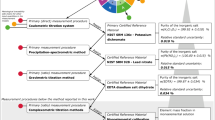Summary
A procedure is described for the determination of the diphenyliodonium cation in the range 1.0 to 4.0 mg, by extraction from solution buffered at pH 9.5 into chloroform as the diethyldithiocarbamate followed by conversion into the copper(II) complex. Absorbance measurements are made on the chloroform solution of the copper(II) diethyldithio-carbamate at 435 nm, and a linear relation exists between absorbance and cation content within the range specified. The optimum conditions for the extraction are discussed.
Zusammenfassung
Ein Verfahren zur Bestimmung von Diphenyliodoniumkationen in der Größenordnung von 1,0 bis 4,0 mg wurde beschrieben. Es beruht auf deren Extraktion aus gepufferter Lösung (pH=9,5) mit Chloroform als Diäthyldithiocarbamat und dessen Überführung in einen Kupfer(II)-komplex. Die Absorption des Kupfer(II)-diäthyldithiocarbamats in Chloroformlösung wurde bei 435 nm gemessen. Sie steht in linearem Verhältnis zur Kationenkonzentration. Die optimalen Bedingungen für die Extraktion werden erörtert.
Résumé
On décrit un procédé pour le dosage du cation diphényliodonium dans le domaine de 1,0 à 4,0 mg, en l'extrayant d'une solution tamponnée à pH 9,5 par le chloroforme, à l'état de diethyldithiocarbamate puis en le transformant en complexe du cuivre-II. On effectue les mesures de densité optique sur la solution dans le chloroforme du diéthyldithiocarbamate de cuivre-II à 435 nm; il existe une relation linéaire entre la densité optique et la teneur en cation dans le domaine spécifié. On discute les conditions optimales pour effectuer l'extraction.
Similar content being viewed by others
References
C. Hartmann andV. Meyer, Ber. dtsch. chem. Ges.27, 502 (1894).
G. M. Schwab andJ. Pechlivanidis, Svensk Kemisk Tidskrift59, 130 (1947).
M. Delepine, C. r. acad. Sci., Paris146, 981 (1908).
M. Delepine, Bull. soc. chim. France3/4, 652 (1908).
H. Bode, Z. analyt. Chem.142, 414 (1954).
H. Bode, Z. analyt. Chem.143, 182 (1954).
H. Bode, Z. analyt. Chem.144, 165 (1955).
R. J. Lacoste, M. H. Earing, andS. E. Wiberley, Analyt. Chemistry23, 871 (1951).
F. Šedivec andV. Vašák, Chem. Listy46, 607 (1952).
F. M. Beringer, M. Drexler, E. M. Gindler andC. C. Lumpkin, J. Amer. Chem. Soc.75, 2705 (1953).
E. B. Sandell, Colorimetric Determination of Traces of Metals, 3rd Ed. New York and London: Interscience. 1959. p. 193.
A. J. Bowd andD. Thorburn Burns, Mikrochim. Acta [Wien]1965, 1151.
A. J. Bowd andD. Thorburn Burns, Mikrochim. Acta [Wien]1966, in the press.
I. Masson, E. Race, andF. E. Pounder, J. Chem. Soc. (London)1935, 1669.
Author information
Authors and Affiliations
Additional information
Part II. Mikrochim. Acta [Wien]1966, 539.
Rights and permissions
About this article
Cite this article
Bowd, A.J., Burns, D.T. Studies on the analytical chemistry of iodonium compounds. Part III. Mikrochim Acta 54, 1051–1058 (1966). https://doi.org/10.1007/BF01217709
Received:
Issue Date:
DOI: https://doi.org/10.1007/BF01217709




